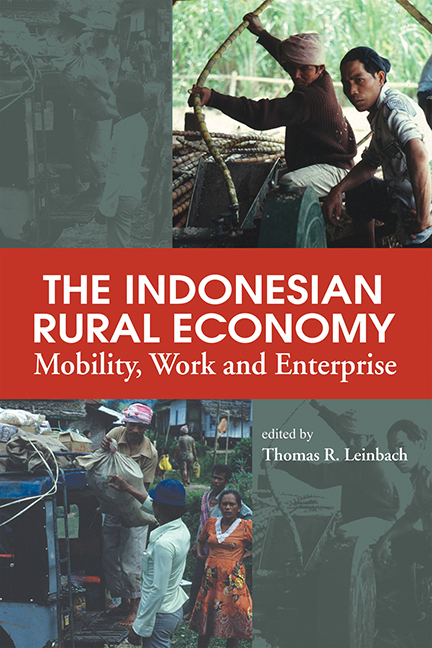Book contents
- Frontmatter
- Content
- List of Tables
- List of Figures
- Contributors
- Acknowledgements
- Glossary
- Foreword
- Part I The Development Context
- Chapter 1 The Indonesian Rural Economy
- Chapter 2 The Changing Importance of Off-Farm Income for Agricultural Households in Indonesia
- Chapter 3 The Economic Policy Environment for Small Rural Enterprises in Indonesia
- Chapter 4 The Contribution of Household and Small Manufacturing Establishments to the Rural Economy
- Part II Entrepreneurship, Gender and Mobility Issues
- Part III Indonesia's Rural Non-Farm Economy: Case Studies and Policy Development
- Index
Chapter 2 - The Changing Importance of Off-Farm Income for Agricultural Households in Indonesia
from Part I - The Development Context
Published online by Cambridge University Press: 21 October 2015
- Frontmatter
- Content
- List of Tables
- List of Figures
- Contributors
- Acknowledgements
- Glossary
- Foreword
- Part I The Development Context
- Chapter 1 The Indonesian Rural Economy
- Chapter 2 The Changing Importance of Off-Farm Income for Agricultural Households in Indonesia
- Chapter 3 The Economic Policy Environment for Small Rural Enterprises in Indonesia
- Chapter 4 The Contribution of Household and Small Manufacturing Establishments to the Rural Economy
- Part II Entrepreneurship, Gender and Mobility Issues
- Part III Indonesia's Rural Non-Farm Economy: Case Studies and Policy Development
- Index
Summary
Rural Households, Agricultural Households and Landowning Households in Rural Indonesia
The twenty-five years from 1970 to 1995 witnessed dramatic changes in the role of agriculture in the Indonesian economy. There was a marked decline in the proportion of total national output (GDP) accruing from the agricultural sector, and the proportion of the labour force employed in agriculture also fell. By 1990, just under half the employed labour force was working in agriculture (in the sense that agriculture was the main source of income), according to the Population Census of that year. Between 1990 and 1995 the absolute size of the agricultural labour force declined, and by 1995 only 44 percent of the employed labour force was reported as “working in agriculture”. This percentage was lower for the densely populated inner islands of Java and Bali where the process of structural change and diversification away from agriculture was especially rapid. If the absolute increase in the employed labour force between 1990 and 1995 is distributed between urban and rural areas, and between economic sectors, it is clear that much of the increase in the non-agricultural labour force occurred in urban areas. In rural areas, which accounted for about one third of the total increase in employment over these five years, much of the growth occurred in the trade and service sector (Table 2.1).
In 1995, the Intercensal Survey (Supas) reported that there were 45.7 million households in Indonesia, of which only about 32 percent were wholly dependent on agriculture for their income, and a further 9.5 percent were largely dependent on agriculture with some non-agricultural income sources. Less than half of the households located in rural areas, which comprised 65 percent of all households, were earning all their income from agriculture in 1995. On the other hand, of those rural households earning at least part of their income from agriculture (over 70 percent of all rural households), the great majority reported that agriculture was either the sole or the main source of their income (Table 2.2). Clearly it would be wrong to argue that the agricultural sector, even before the crisis of 1997, was not an important source of income for many millions of rural households in Indonesia.
- Type
- Chapter
- Information
- The Indonesian Rural EconomyMobility, Work and Enterprise, pp. 15 - 37Publisher: ISEAS–Yusof Ishak InstitutePrint publication year: 2003



